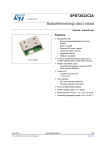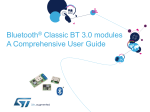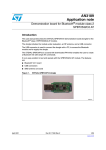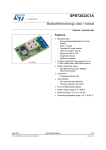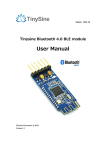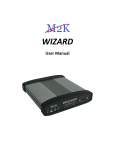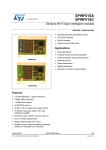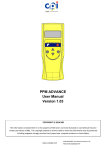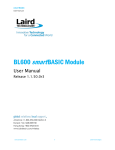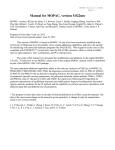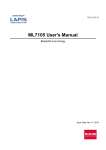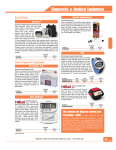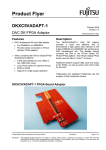Download SPBT2932DM
Transcript
SPBT2932DM Bluetooth® v4.0 smart ready module Datasheet - preliminary data Application • Serial cable replacement • M2M industrial control • Service diagnostic • Data acquisition equipment • Machine control • Sensor monitoring • Security system 11.6 mm x 13.5 mm Description Features • Bluetooth radio – Fully embedded Bluetooth v4.0 with profiles – Class 1 radio – 128-bit encryption security – Integrated antenna – Dual mode Bluetooth classic and low energy supported • ST Micro Cortex-M4 microprocessor up to 84 MHz (256 kb Flash, 48 kb RAM) • Serial interface – UART The SPBT2932DM micro-sized Bluetooth smart ready module with integrated antenna boasts the smallest form factor available for a complete RF platform. The SPBT2932DM is a surface mount PCB module that provides fully embedded, ready-touse Bluetooth wireless technology. The SPBT2932DM supports both Bluetooth classic and low energy (LE), version v4.0. Our standard AT command set and Bluetooth stack are pre-Flashed into the integrated Flash memory, supporting Bluetooth 3.0 profiles and Bluetooth 4.0 services. Commands will be listed in the FW user manual UM1801. • General I/O – 8 general purpose I/O – 1 LPO input • User interface – AT command set (abSerial) – Firmware upgrade over UART • CE, FCC and BQE qualification (pending) • Single voltage supply: 2.5 V (typ) • Micro-sized form factor: 11.6 x 13.5 x 2.9 mm • RoHS compliance September 2014 DocID026716 Rev 2 This is preliminary information on a new product now in development or undergoing evaluation. Details are subject to change without notice. 1/25 www.st.com Contents SPBT2932DM Contents 1 2 Software architecture . . . . . . . . . . . . . . . . . . . . . . . . . . . . . . . . . . . . . . . . 4 1.1 Lower layer stack . . . . . . . . . . . . . . . . . . . . . . . . . . . . . . . . . . . . . . . . . . . . 4 1.2 Upper layer stack: Data FW . . . . . . . . . . . . . . . . . . . . . . . . . . . . . . . . . . . . 4 1.3 AT Command Set . . . . . . . . . . . . . . . . . . . . . . . . . . . . . . . . . . . . . . . . . . . . 4 1.4 Bluetooth firmware implementation . . . . . . . . . . . . . . . . . . . . . . . . . . . . . . 5 Hardware specifications . . . . . . . . . . . . . . . . . . . . . . . . . . . . . . . . . . . . . . 6 2.1 Recommended operating conditions . . . . . . . . . . . . . . . . . . . . . . . . . . . . . 6 2.2 Absolute maximum ratings . . . . . . . . . . . . . . . . . . . . . . . . . . . . . . . . . . . . . 6 2.3 CPU current consumption . . . . . . . . . . . . . . . . . . . . . . . . . . . . . . . . . . . . . 6 2.4 I/O operating characteristics . . . . . . . . . . . . . . . . . . . . . . . . . . . . . . . . . . . . 7 2.5 Selected RF characteristics . . . . . . . . . . . . . . . . . . . . . . . . . . . . . . . . . . . . 7 2.6 Pin assignment . . . . . . . . . . . . . . . . . . . . . . . . . . . . . . . . . . . . . . . . . . . . . . 8 3 Mechanical dimensions . . . . . . . . . . . . . . . . . . . . . . . . . . . . . . . . . . . . . 11 4 Hardware block diagram . . . . . . . . . . . . . . . . . . . . . . . . . . . . . . . . . . . . . 13 5 Hardware design . . . . . . . . . . . . . . . . . . . . . . . . . . . . . . . . . . . . . . . . . . . 14 5.1 Module reflow installation . . . . . . . . . . . . . . . . . . . . . . . . . . . . . . . . . . . . . 14 5.2 GPIO interface . . . . . . . . . . . . . . . . . . . . . . . . . . . . . . . . . . . . . . . . . . . . . 15 5.3 GPIO configuration . . . . . . . . . . . . . . . . . . . . . . . . . . . . . . . . . . . . . . . . . . 15 5.4 UART interface . . . . . . . . . . . . . . . . . . . . . . . . . . . . . . . . . . . . . . . . . . . . . 15 5.5 PCB layout guideline . . . . . . . . . . . . . . . . . . . . . . . . . . . . . . . . . . . . . . . . 17 5.6 Reset circuit . . . . . . . . . . . . . . . . . . . . . . . . . . . . . . . . . . . . . . . . . . . . . . . 17 5.7 2/25 5.6.1 External reset circuit . . . . . . . . . . . . . . . . . . . . . . . . . . . . . . . . . . . . . . . 17 5.6.2 Internal reset circuit . . . . . . . . . . . . . . . . . . . . . . . . . . . . . . . . . . . . . . . . 18 External LPO input circuit . . . . . . . . . . . . . . . . . . . . . . . . . . . . . . . . . . . . . 18 DocID026716 Rev 2 SPBT2932DM 6 Contents Regulatory compliance . . . . . . . . . . . . . . . . . . . . . . . . . . . . . . . . . . . . . . 20 6.1 FCC and IC certification . . . . . . . . . . . . . . . . . . . . . . . . . . . . . . . . . . . . . . 20 6.2 Bluetooth certification . . . . . . . . . . . . . . . . . . . . . . . . . . . . . . . . . . . . . . . . 20 6.3 CE certification . . . . . . . . . . . . . . . . . . . . . . . . . . . . . . . . . . . . . . . . . . . . . 21 7 Traceability . . . . . . . . . . . . . . . . . . . . . . . . . . . . . . . . . . . . . . . . . . . . . . . . 22 8 Ordering information . . . . . . . . . . . . . . . . . . . . . . . . . . . . . . . . . . . . . . . 23 9 Revision history . . . . . . . . . . . . . . . . . . . . . . . . . . . . . . . . . . . . . . . . . . . 24 DocID026716 Rev 2 3/25 25 Software architecture SPBT2932DM 1 Software architecture 1.1 Lower layer stack 1.2 1.3 • Bluetooth v4.0 classic and low energy • Device power modes: active, sleep and deep sleep • Wake on Bluetooth feature for optimized power consumption of host CPU • Authentication and encryption • Encryption key length from 8-bits to 128-bits • Persistent Flash memory for BD address and user parameter storage • All ACL (asynchronous connection-less) packet types Upper layer stack: Data FW • SPP and iAP Classic profiles, battery and private low energy services • Protocols: classic (RFCOMM, SDP, L2CAP). Low energy (ATT/GATT) AT Command Set The complete command list including the Bluetooth classic and low energy commands is included in user manual UM1801. 4/25 DocID026716 Rev 2 SPBT2932DM 1.4 Software architecture Bluetooth firmware implementation Figure 1. FW architecture DocID026716 Rev 2 5/25 25 Hardware specifications 2 SPBT2932DM Hardware specifications General conditions (VIN= 2.5 V and 25 °C) 2.1 Recommended operating conditions Table 1. Recommended operating conditions Rating Min. Operating temperature range(1) -20 Supply voltage VIN 2.0 Signal pin voltage Typ. Max. Unit 60 °C 3.6 V 2.5 2.1 RF frequency 2402 V 2483.5 MHz Max. Unit 105 °C 1. T value will be published at the end of module qualification test. 2.2 Absolute maximum ratings Table 2. Absolute maximum ratings Rating Min. Typ. Storage temperature range -55 Supply voltage VIN -0.3 2.5 5.0 V I/O pin voltage (VIO five-volt tolerant pin) -0.3 2.1 5.5 V -5 dBm RF input power 2.3 CPU current consumption • Standard CPU mode 8 MHz • UART supports up to 115 Kbps • Data throughput up to 200 Kb • FW version 1.5 • Shallow sleep enabled Table 3. Current consumption Modes (typical power consumption) 6/25 Avg Unit ACL data 115 K baud UART at max. throughput (master) 16.5 mA ACL data 115 K baud UART at max. throughput (slave) 18.5 mA Connection, no data traffic, master 5.2 mA Connection, no data traffic, slave 7.4 mA DocID026716 Rev 2 SPBT2932DM Hardware specifications Table 3. Current consumption (continued) Modes (typical power consumption) Avg Unit Connection 375 ms sniff (external LPO required) 590 µA Standby, without deep sleep 4.9 mA Standby, with deep sleep, no external LPO 1.2 mA Standby, with deep sleep, with external LPO 140 µA Page/inquiry scan, with deep sleep, no external LPO 2.6 mA Page/inquiry scan, with deep sleep, with external LPO 720 µA BLE advertising, 1.28sec non-connectable, with external LPO 195 µA BLE advertising, 1.28sec discoverable, with external LPO 215 µA 11 µA Bluetooth power down / CPU standby 2.4 I/O operating characteristics Table 4. I/O operating characteristics 2.5 Symbol Parameter Min. Max. Unit Conditions Vil Low-level input voltage - 0.6 V VIN, 2.1 V VIH High-level input voltage 1.4 - V VIN, 2.1 V VOL Low-level output voltage - 0.4 V VIN, 2.1 V VOH High-level output voltage 1.8 - V VIN, 2.1 V IOL Low-level output current - 4.0 mA VOL = 0.4 V IOH High-level output current - 4.0 mA VOH = 1.8 V RPU Pull-up resistor 80 120 kΩ Resistor turned on RPD Pull-down resistor 80 120 kΩ Resistor turned on Selected RF characteristics Table 5. Selected RF characteristics Parameters Conditions Typical(1) Antenna load Unit 50 ohm Radio receiver Sensitivity level BER <.001 with DH5 -92 dBm Maximum usable level BER <.001 with DH1 0 dBm DocID026716 Rev 2 7/25 25 Hardware specifications SPBT2932DM Table 5. Selected RF characteristics (continued) Parameters Conditions Typical(1) Input VSWR Unit 2.5:1 Radio transmitter Maximum output power 50 Ω load + 12 dBm Initial carrier frequency tolerance 0 kHz 20 dBm bandwidth for modulated carrier 935 kHz 1. RF characteristics can be influenced by physical characteristics of final application. 2.6 Pin assignment Figure 2. Pin connection diagram 8/25 DocID026716 Rev 2 SPBT2932DM Hardware specifications Table 6. Pin assignment Name Type Pin # ALT function Description 5 V tolerant Initial state UART interface RXD I 13 Receive data Y TXD O 14 Transmit data Y RTS O 12 Clear to send (active low) I2C data Y CTS I 11 Request to send (active low) I2C clock Y Boot loader Boot 0 I 9 Boot 0 Power and ground Vin 8 Vin GND 7 GND LDout 18 LDO output 2.1 V Reset RESETN I 10 Reset input (active low for 5 ms) (1.8 V + 0.3 V) max. LPO LPCLK I 15 LPO input GPIO – general purpose input/output GPIO [1] I/O 1 General purpose input/output GPIO [2] I/O 2 General purpose input/output GPIO [3] I/O 3 GPIO [4] I/O GPIO [5] I/O Y Input pull down I2S_SD Y Floating General purpose input/output I2S_CLCK Y Input pull down 4 General purpose input/output I2S_WS Y Input pull down 5 General purpose input/output I2C data Y Input pull down DocID026716 Rev 2 9/25 25 Hardware specifications SPBT2932DM Table 6. Pin assignment (continued) 10/25 Name Type Pin # Description ALT function 5 V tolerant Initial state GPIO [6] I/O 6 General purpose input/output I2C clock Y Input pull down GPIO [7] I/O 17 General purpose input/output ADC 0 Y Input pull down GPIO [8] I/O 16 General purpose input/output ADC 1 Y Input pull down DocID026716 Rev 2 SPBT2932DM 3 Mechanical dimensions Mechanical dimensions In order to meet environmental requirements, ST offers these devices in different grades of ECOPACK® packages, depending on their level of environmental compliance. ECOPACK® specifications, grade definitions and product status are available at: www.st.com. ECOPACK® is an ST trademark. Figure 3. Mechanical dimensions DocID026716 Rev 2 11/25 25 Mechanical dimensions SPBT2932DM Figure 4. Recommended land pattern 12/25 DocID026716 Rev 2 SPBT2932DM 4 Hardware block diagram Hardware block diagram Figure 5. SPBT2932DM module block diagram DocID026716 Rev 2 13/25 25 Hardware design 5 SPBT2932DM Hardware design The SPBT2932DM module supports UART and GPIO hardware interfaces. Please note that: 5.1 • All unused pins should be left floating; do not ground. • All GND pins must be well grounded. • The area around the module should be free of any ground planes, power planes, trace routings, or metal for 6 mm from the antenna in all directions. • Traces should not be routed underneath the module. Module reflow installation The SPB2932DM is a surface mount Bluetooth module supplied on an 18-pin, 6-layer PCB. The final assembly recommended reflow profiles are indicated below. The soldering phase must be executed with care. In order to avoid the undesired melting, particular attention must be taken during the setup of the peak temperature. The following provides some suggestions for the temperature profile based on IPC/JEDEC J-STD-020C, July 2004 recommendations. Table 7. Soldering Profile feature Average ramp-up rate (TSMAX to Tp) Preheat Temperature min (TS min) Temperature max (TS max) Time (tS min to tS max) (tS) PB-free assembly 3 °C/sec max 150 °C 200 °C 60-100 sec Time maintained above: Temperature TL Time tL 217 °C 60-70 sec Peak temperature (Tp) 240 + 0 °C Time within 5 °C of actual peak temperature (tP) 10-20 sec Ramp-down rate 6 °C/sec Time from 25 °C to peak temperature 14/25 DocID026716 Rev 2 8 minutes max SPBT2932DM Hardware design Figure 6. Soldering profile 5.2 GPIO interface All GPIOs are capable of sinking and sourcing 6 mA of I/O current. GPIO [1] to GPIO [8] are internally pulled down with 100 kΩ (nominal) resistors, except GPIO [2], which is floating. 5.3 GPIO configuration Module GPIO configuration depends on the FW embedded. GPIO can be reconfigured using the following commands: • At+ab gpioconfig [GPIO pin] [I/O] • At+ab gpioRead [GPIO pin] • At+ab gpioWrite [GPIO pin] [1/0] For additional details, refer to user manual UM1801. 5.4 UART interface The UART is compatible with the 16550 industry standard. Four signals are provided with the UART interface. The TXD and RXD pins are used for data while the CTS and RTS pins are used for flow control. DocID026716 Rev 2 15/25 25 Hardware design SPBT2932DM Figure 7. Connection to host device Figure 8. Typical RS232 circuit 16/25 DocID026716 Rev 2 SPBT2932DM 5.5 Hardware design PCB layout guideline Figure 9. PCB layout guideline 5.6 Reset circuit Two types of system reset circuits are detailed below. The maximum voltage that can be supplied to the RESET pin is 2.5 V. As shown in Figure 10 and Figure 11, the RESET is active low. In the absence of a reset circuit, the pin is internally pulled up and therefore inactive. 5.6.1 External reset circuit Figure 10. External reset circuit Note: RPU ranges from 30 kW to 50 kW internally. DocID026716 Rev 2 17/25 25 Hardware design 5.6.2 SPBT2932DM Internal reset circuit Figure 11. Internal reset circuit Note: RPU ranges from 30 kW to 50 kW internally. RRST should be from 1 kW to 10 kW. 5.7 External LPO input circuit An optional low power oscillator input may be added to allow deep sleep and sniff modes. • LPO parameters: • – Frequency: 32.768 kHz – Tolerance: +/- 150 ppm typical, +/- 250 maximum – Absolute maximum supplied voltage at LPO pin: +1.8 V – VIL min/max = 0 V/+0.5 V – VIH min/max = +1.47 V/+1.8 V – Input capacitance: 2.5 pF maximum Configurations: – Use two configuration variables: UseExtLPO and AllowSniff. Table 8. System configuration variables Variable 18/25 Name Default Description Var.. UseExtLPO auto True when a 32.768 kHz low power oscillator is present, and false if not present. Var.. AllowSniff false Enables sniff mode. Must be false when no 32.768 kHz LPO is present. DocID026716 Rev 2 SPBT2932DM Hardware design Figure 12. External LPO circuit G PIO02 3 4 16 17 15 LPO 2 G PIO08 G PIO01 G PIO07 1 LDOUT B T1 18 LPO T XD 14 R XD 13 G PIO03 R TS 12 G PIO04 C TS 11 5 G PIO05 R ES ET 10 6 G PIO06 BOOT 9 7 G ND V IN 8 S PB T2932DM DocID026716 Rev 2 19/25 25 Regulatory compliance SPBT2932DM 6 Regulatory compliance 6.1 FCC and IC certification This module has been tested and found to comply with the FCC part 15 and IC RSS-210 rules. These limits are designed to provide reasonable protection against harmful interference in approved installations. This equipment generates, uses, and can radiate radio frequency energy and, if not installed and used in accordance with the instructions, may cause harmful interference to radio communications. However, there is no guarantee that interference may not occur in a particular installation. This device complies with part 15 of the FCC rules. Operation is subject to the following two conditions: 1. this device may not cause harmful interference 2. this device must accept any interference received, including interference that may cause undesired operation. Modifications or changes to this equipment not expressly approved by the part responsible for compliance may render void the user's authority to operate this equipment. – Modular approval, FCC and IC FCC ID: X3ZBTMOD7 IC: 8828A-MOD7 In accordance with FCC part 15, the SPBT2932DM is listed above as a modular transmitter device. – Label instructions When integrating the SPBT2932DM into the final product, it must be ensured that the FCC labeling requirements, as specified below, are satisfied. Based on the public notice from FCC, the product into which the ST transmitter module is installed must display a label referring to the enclosed module. The label should use wording such as the following: Contains transmitter module FCC ID: X3ZBTMOD7 IC: 8828A-MOD7 Any similar wording that expresses the same meaning may be used. 6.2 Bluetooth certification The module with embedded stack and profile has been qualified according to SIG qualification rules: 20/25 • Bluetooth SIG Qualified Design, QD ID: 58674 • Product type: End Product • TGP version: Core 4.0 • Core spec version: 4.0 • Product descriptions: Bluetooth module, spec v4.0 DocID026716 Rev 2 SPBT2932DM 6.3 Regulatory compliance CE certification Module has been certified according to following certification rules: • CE Expert Opinion: TBD • Measurements have been performed in accordance with (report available on request): – EN 300 328 V 1.8.1 (2012 06) (a) – EN 301 489-17 V 2.2.1 (2012 09) (b) – EN 301 489 -1 V 1.9.2 (2011 09) (c) – EN60950-1:2006 +A11:2009+A1:2010 (d) CE certified: a. EN 300 328 V 1.8.1 (2012 06): “Electromagnetic compatibility and radio spectrum matters (ERM); Wideband transmission systems; data transmission equipment operating in the 2.4 GHz ISM band and using wideband modulation techniques; harmonized EN covering essential requirements under article 3.2 of the R&TTE directive”. b. EN 301 489-17 V 2.2.1 (2012 09): “Electromagnetic compatibility and radio spectrum matters (ERM); Electromagnetic compatibility (EMC) standard for radio equipment and services; part 17: specific condition for 2.4 GHz wideband transmission systems and 5 GHz high performance RLAN equipment”. c. EN301 489-1 V 1.9.2 (2011 09): “Electromagnetic compatibility and radio spectrum Matters (ERM); Electromagnetic compatibility (EMC) standard for radio equipment and services; part 1: Common technical requirements”. d. EN60950-1:2006 +A11:2009+A1:2010: “Information technology equipment - safety”. DocID026716 Rev 2 21/25 25 Traceability 7 SPBT2932DM Traceability Each module is uniquely identified by a serial number stored in a 2D data matrix lasermarked on the bottom side of the module. The serial number has the following format: WW YY D FF NNN Where: – WW = week – YY = year – D = product ID family – FF = production panel coordinate identification – NNN = progressive serial number Each module bulk is identified by a bulk ID. Bulk ID and module 2D data matrix are linked by a reciprocal traceability link. The module 2D data matrix traces the lot number of any raw material used. 22/25 DocID026716 Rev 2 SPBT2932DM 8 Ordering information Ordering information Table 9. Ordering information Order code Description Packing MOQ SPBT2932DM Bluetooth V4.0 data module JEDEC tray 2448 pcs DocID026716 Rev 2 23/25 25 Revision history 9 SPBT2932DM Revision history Table 10. Document revision history 24/25 Date Revision Changes 05-Sep-2014 1 Initial release. 23-Sep-2014 2 Table 1 has been modified. Document status promoted from product preview to preliminary data. DocID026716 Rev 2 SPBT2932DM IMPORTANT NOTICE – PLEASE READ CAREFULLY STMicroelectronics NV and its subsidiaries (“ST”) reserve the right to make changes, corrections, enhancements, modifications, and improvements to ST products and/or to this document at any time without notice. Purchasers should obtain the latest relevant information on ST products before placing orders. ST products are sold pursuant to ST’s terms and conditions of sale in place at the time of order acknowledgement. Purchasers are solely responsible for the choice, selection, and use of ST products and ST assumes no liability for application assistance or the design of Purchasers’ products. No license, express or implied, to any intellectual property right is granted by ST herein. Resale of ST products with provisions different from the information set forth herein shall void any warranty granted by ST for such product. ST and the ST logo are trademarks of ST. All other product or service names are the property of their respective owners. Information in this document supersedes and replaces information previously supplied in any prior versions of this document. © 2014 STMicroelectronics – All rights reserved DocID026716 Rev 2 25/25 25


























